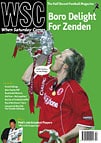 In January the editor responsible for the creation of Roy of the Rovers, the most famous of all football comic strips, died. Neil Rose looks at the life of Derek Birnage’s brainchild, while there have also been more recent developments in the industry
In January the editor responsible for the creation of Roy of the Rovers, the most famous of all football comic strips, died. Neil Rose looks at the life of Derek Birnage’s brainchild, while there have also been more recent developments in the industry
He lost his wife in a mysterious car crash, his left foot in a helicopter accident, eight of his team-mates in a Middle Eastern terrorist attack and in January Roy Race suffered further loss when the man who brought him to the world died, almost 50 years after Racey’s Rocket first slammed into the net.
Derek Birnage was the launch editor of Tiger – “The Sport and Picture Story Weekly” – on September 11, 1954, and had asked Frank Pepper to produce a more realistic football comic strip than his Danny of the Dazzlers, which featured in Champion. And so Roy of the Rovers and his best friend Blackie Gray were born. (Blackie has been one of the few lucky ones to make it alive through knowing Roy, although it was touch and go in 1990 after a car crash.)
Birnage gradually assumed scripting responsibilities for the strip and in 1960 the front page announced that Bobby Charlton had taken over writing Roy’s adventures, complete with a cartoon of him tapping away at a typewriter. In reality Birnage was still doing the work, although he apparently interviewed the combed-over one every fortnight to get ideas.
In a playing career spanning an impressive 39 years, Roy and Melchester Rovers won around ten league titles, one Second Division title (in pre-Premiership days), eight FA Cups, three League Cups, four European Cups, three European Cup-Winners Cups, a solitary UEFA Cup and two World Club Championships. The 1960s were the period of greatest success – only later did the authors consider it OK for Melchester to lose regularly – and Roy hit his 300th goal by 1968. It didn’t seem like it, but he slowed down thereafter, weighed down perhaps by the burden of many years as player-manager, and only beat the league goalscoring record in 1992 when he notched his 436th goal with the strike that won Melchester the title.
There were plenty of other distractions – the Who shot Roy Race? saga that followed hot on the heels of Who shot JR? (it turned out to be an actor sacked from playing Roy in a TV soap), which led to Sir Alf Ramsey stepping in as caretaker manager; the earthquake that ripped across Mel Park and led to Melchester playing temporarily at Wembley many years before Arsenal thought of it; and countless tours to South America that always led to the team being kidnapped.
Sir Alf was just one of many famous faces to pass through the strip, which became the title of a comic of its own in 1976. Geoff Boycott was chairman for a time, while DJ Simon Mayo no doubt gave everyone a huge boost when he was named honorary vice-president in 1990. Emlyn Hughes and Bob Wilson turned out for Melchester, as did the less proven footballing talents of Spandau Ballet’s Martin Kemp and Steve Norman. When, shortly before the comic folded, Roy resigned as manager, he did so on Sky in front of a shocked Richard Keys and Andy Gray.
During its peak Roy of the Rovers sold 200,000 copies a week and Roy certainly marketed himself actively. He sponsored cult Portsmouth striker Alan Biley in 1984-85, wrote for the Reading programme, was in a Melchester Subbuteo team and even joined forces with Gary Lineker in 1990 to produce a record called Europe United. It is scarily described as a “hot rocking heavy metal rap”, with Gary and Roy on vocals and Roy also on lead guitar.
The last edition was published on March 23, 1993. The strip then had a 19-issue run as a monthly, with Roy managing in Italy while his son Rocky took over as Melchester’s star striker. Roy returned as boss in 1997 in the pages of Match of the Day magazine and helped reverse what had been a Liverpool-like fall from grace in the Premiership era. Since that went under in 2001 (not long after a fan rather morbidly died of sadness after the last game at Mel Park), the exploits of Roy and Rocky can only be imagined, although tragedy presumably stalks them at every turn.
But the legend lives on, through Toffs selling the Melchester shirt, activity on Ebay (the original Tiger goes for £60, the Gary Lineker record for £3), the memories of those such as me who would run downstairs on a Saturday morning when the comic dropped through the letterbox and for as long as some exceptional feat is declared to be “real Roy of the Rovers stuff”.
From WSC 206 April 2004. What was happening this month